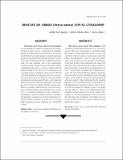Mostrar el registro sencillo del ítem
Rescate de arroz (Oryza sativa) con el cyhalofop
Rice (Oryza sativa) rescue with cyhalofop
| dc.creator | Soto Aguilar, Adolfo | |
| dc.creator | Vallejos Ruíz, Eitbel | |
| dc.creator | Rojas, Carlos | |
| dc.date.accessioned | 2019-08-08T21:12:56Z | |
| dc.date.available | 2019-08-08T21:12:56Z | |
| dc.date.issued | 1997 | |
| dc.identifier.issn | 1011-8516 | |
| dc.identifier.uri | https://hdl.handle.net/10669/78829 | |
| dc.description.abstract | Con la finalidad de estudiar la tolerancia de dos cultivares de arroz (Oryza sativa) a varias dosis de cyhalofop, durante tres etapas de su ciclo reproductivo, así como la sensibilidad de conocidas especies de malezas gramíneas que provocan infestaciones tardías en el cultivo, se realizaron cuatro experimentos en dos localidades de Guanacaste. En cada localidad, uno de los experimentos consistió en dejar las malezas crecer a partir del completo ahijamiento del cultivo y el otro, se mantuvo libre de malezas durante el ciclo del arroz. Los tratamientos que se evaluaron fueron cyhalofop en dosis de 120, 180, 240 y 300 g/ha aplicados en la época de panzoneo, a la emergencia del primordio y a la floración; se incluyó además un tratamiento con fenoxaprop 90 g/ha y otro testigo (sin herbicida a partir del completo ahijamiento). Se encontró que el arroz toleró al cyhalofop durante las fases reproductivas evaluadas, mientras que en el caso del fenoxaprop la tolerancia parece estar relacionada con el cultivar; no ocurrieron diferencias entre cyhalofop y fenoxaprop en cuanto a combate de malezas. Gramíneas de importancia económica en el arroz presentaron el siguiente orden de tolerancia, de mayor a menor, al cyhaofop: Ischaemun rugosum, Digitaria sp. y Rottboellia exaltata. | es_ES |
| dc.description.abstract | With the purpose of studying the tolerance of two rice (Oryza sativa) cultivars to several doses of cyhalofop, during three stages of their reproductive cycle, as well as the sensibility of known species of gramineous weeds that induce late infestations in the rice crop, four experiments were conducted in two locations of Guanacaste, Costa Rica. In one of the experiments, the weeds were allowed to grow starting from the complete tillering of the rice, the other was kept free of weeds during the rice cycle. The treatments evaluated were cyhalofop in doses of 120, 180, 240 and 300 g/ha applied at the booth, at the emergence of the primordium and at the blooming stages; it also included a treatment with fenoxaprop 90 g/ha and a control (without herbicide after the complete tillering). It was concluded that the rice tolerated the cyhalofop during the reproductive phases, while in the case of the fenoxaprop the tolerance seems to be related with the cultivars. There were no differences between cyhalofop and fenoxaprop as for weeds’ control. Gramineous of economical importance to the rice showed the following order of tolerance, from higher to lower, to the cyhalofop: Ischaemun rugosum, Digitaria sp. and Rottboellia exaltata. | en_US |
| dc.format | application/pdf | |
| dc.language.iso | es | es_ES |
| dc.publisher | Universidad de Costa Rica | es-ES |
| dc.rights | Todos los derechos reservados 1997 | * |
| dc.source | Boletín Técnico, Vol 30(1), pp. 41-49 | es_ES |
| dc.subject | Oryza sativa | es_ES |
| dc.subject | malezas | es_ES |
| dc.subject | herbicidas | es_ES |
| dc.subject | control químico | es_ES |
| dc.subject | Costa Rica | es_ES |
| dc.subject | Oryza sativa | es_US |
| dc.subject | weeds | es_US |
| dc.subject | herbicides | es_US |
| dc.subject | chemical control | es_US |
| dc.subject | Costa Rica | es_US |
| dc.title | Rescate de arroz (Oryza sativa) con el cyhalofop | es_ES |
| dc.title | Rice (Oryza sativa) rescue with cyhalofop | en_US |
| dc.type | artículo original | |
| dc.description.procedence | UCR::Vicerrectoría de Investigación::Unidades de Investigación::Ciencias Agroalimentarias::Estación Experimental Agrícola Fabio Baudrit Moreno (EEAFBM) | es_ES |
Ficheros en el ítem
Este ítem aparece en la(s) siguiente(s) colección(ones)
-
Vol. 30 [15]


